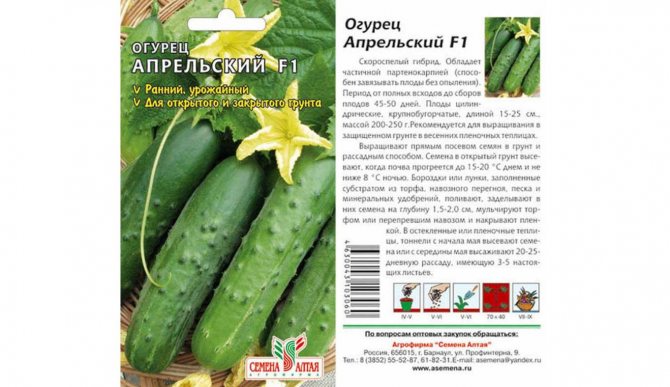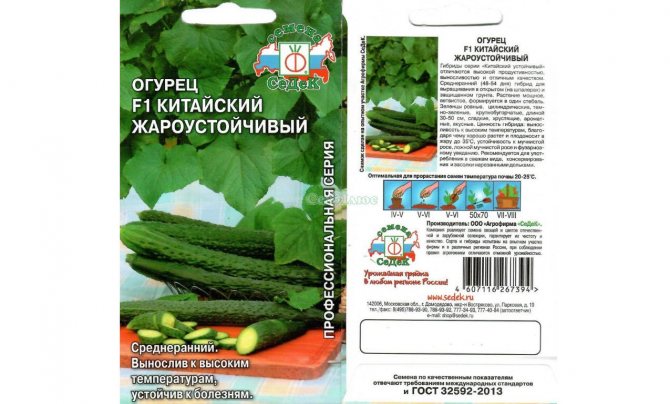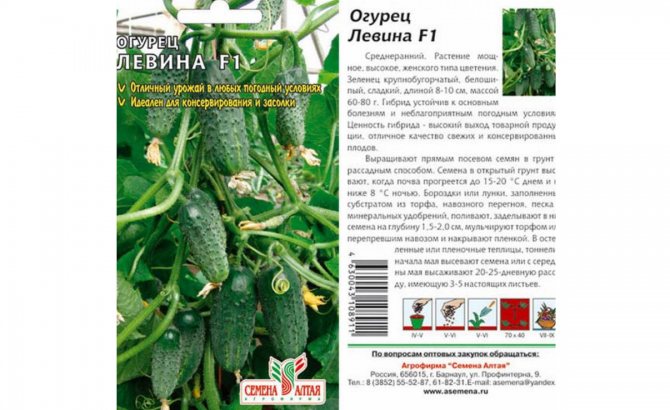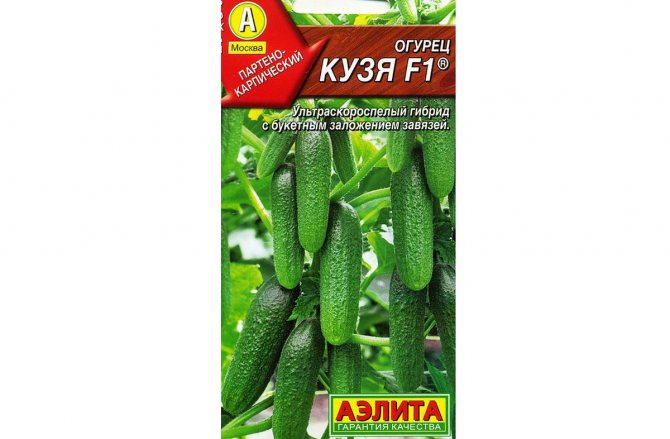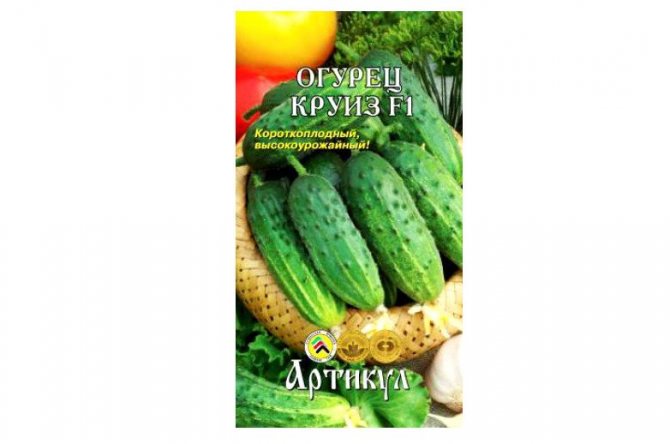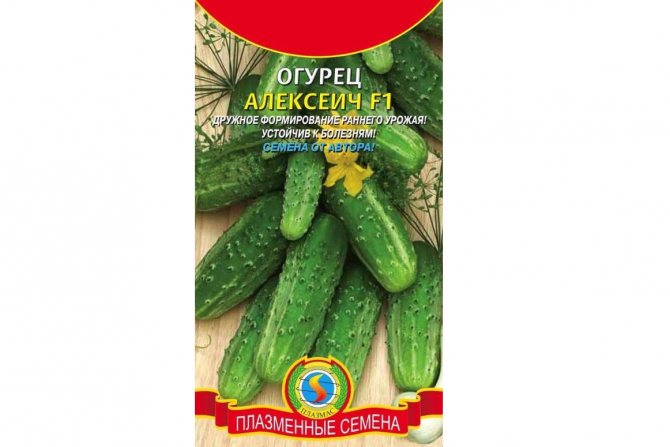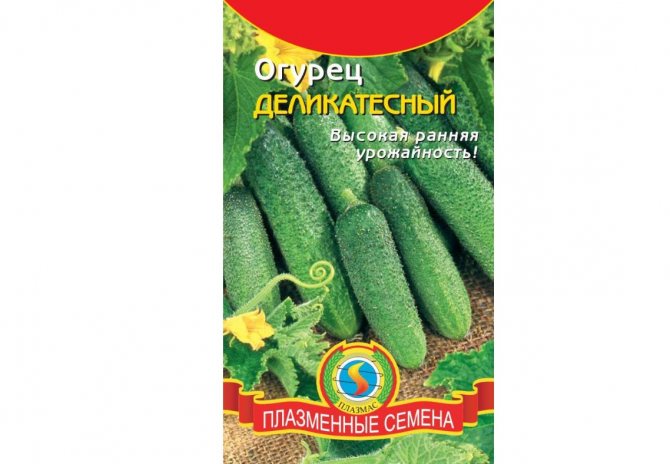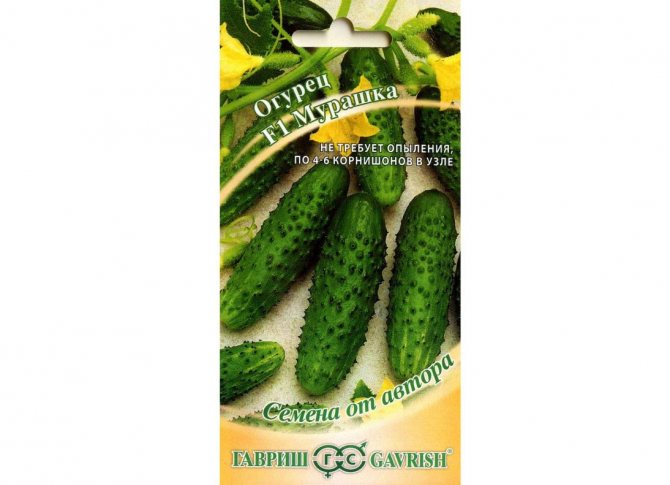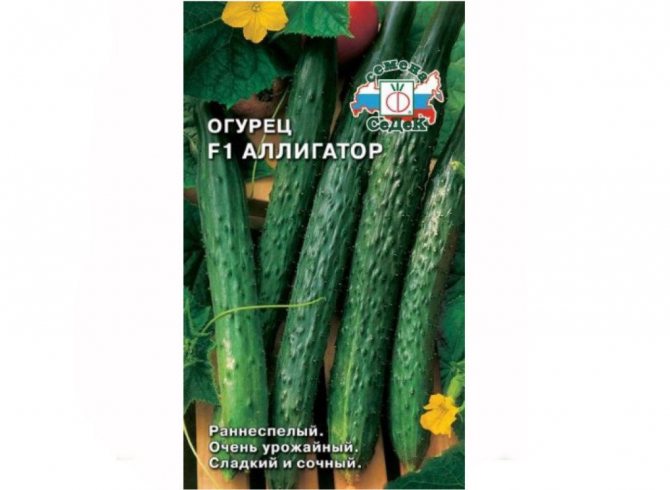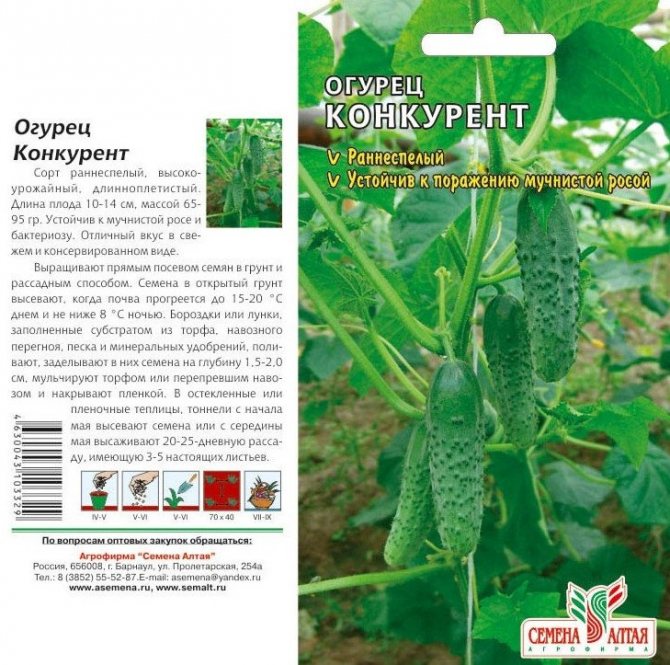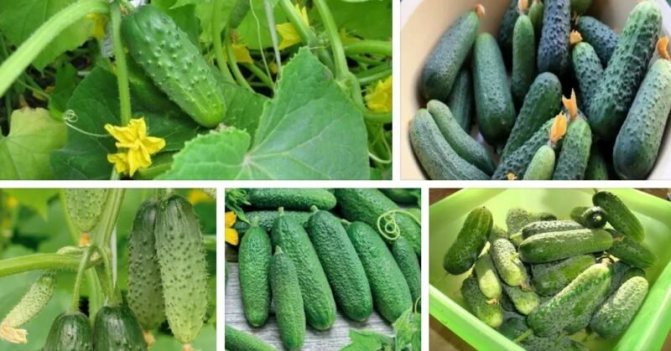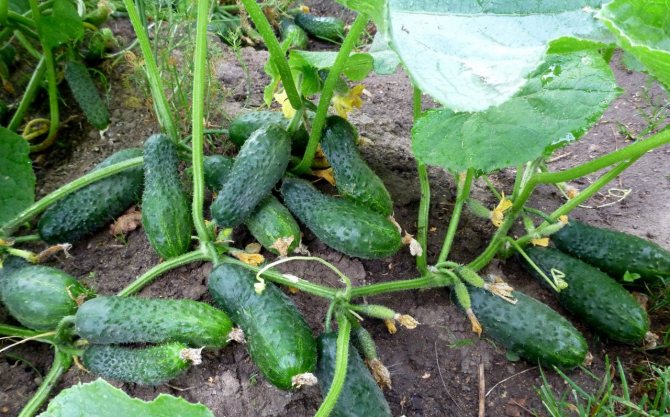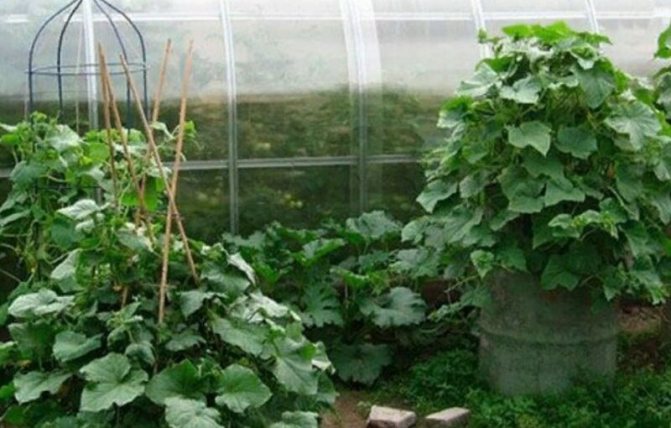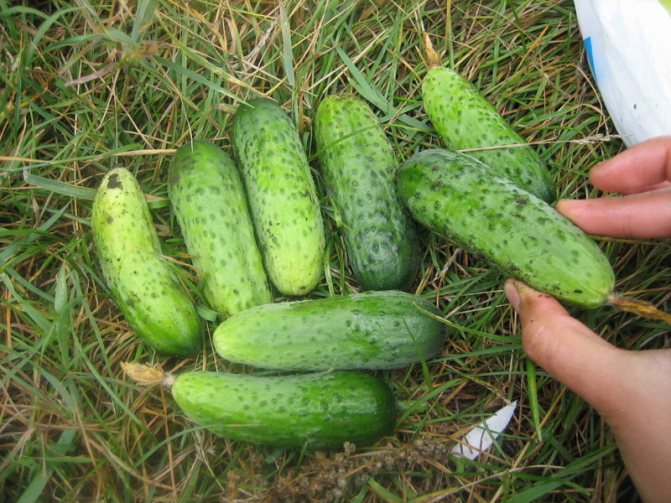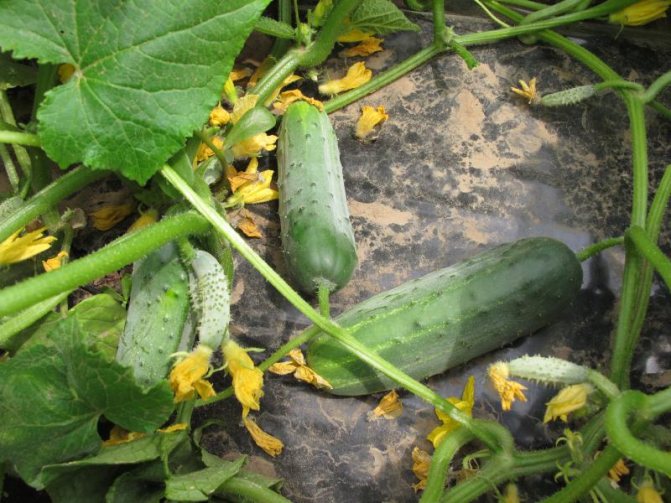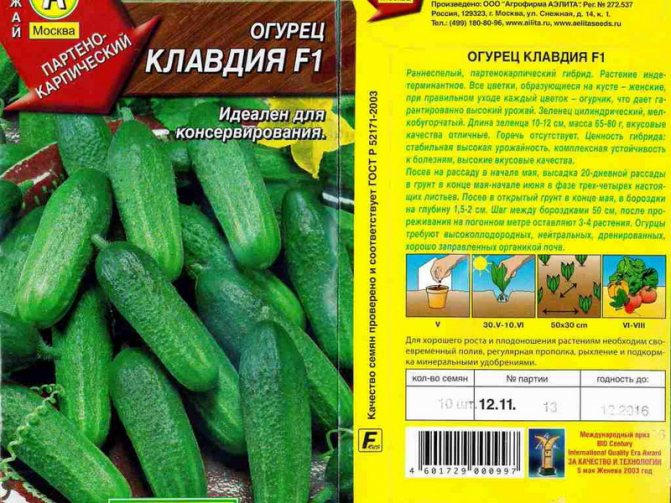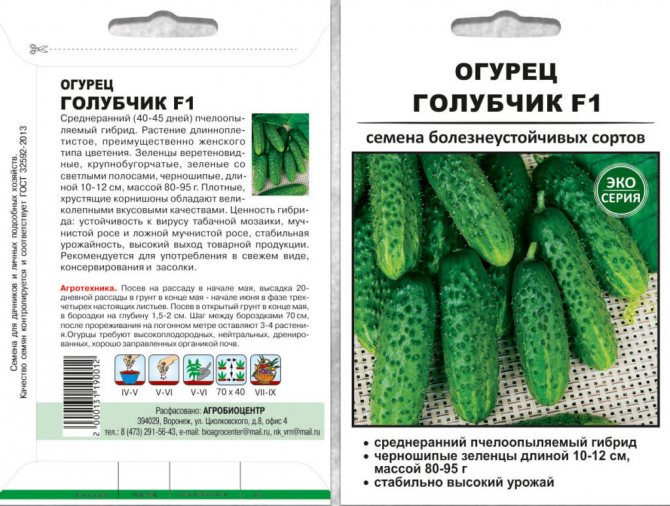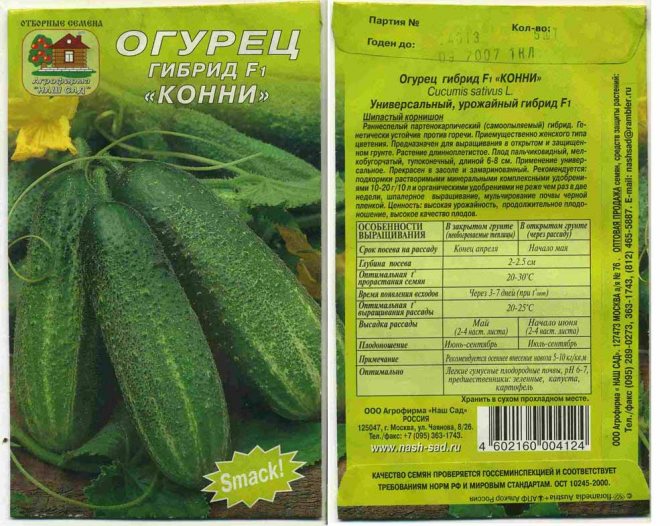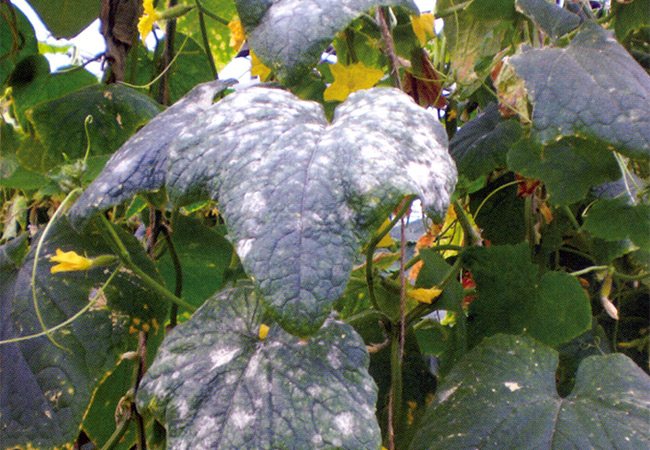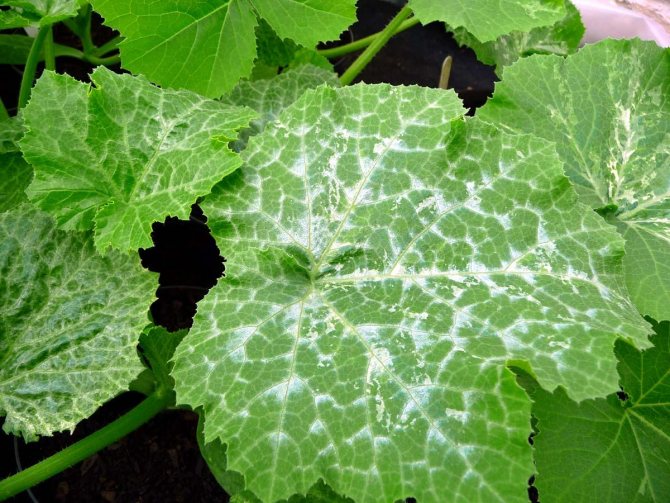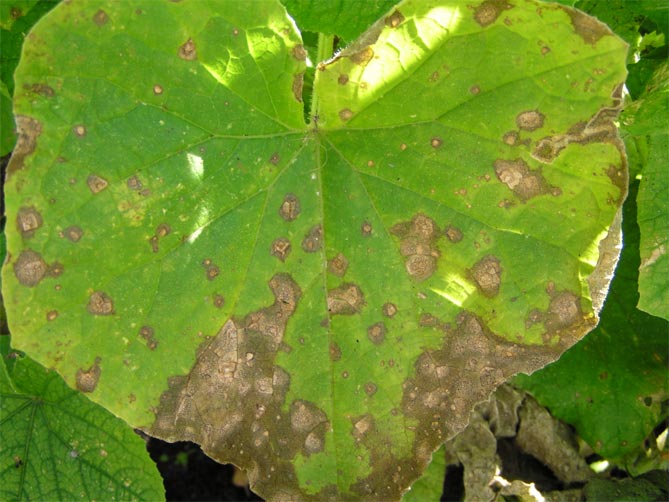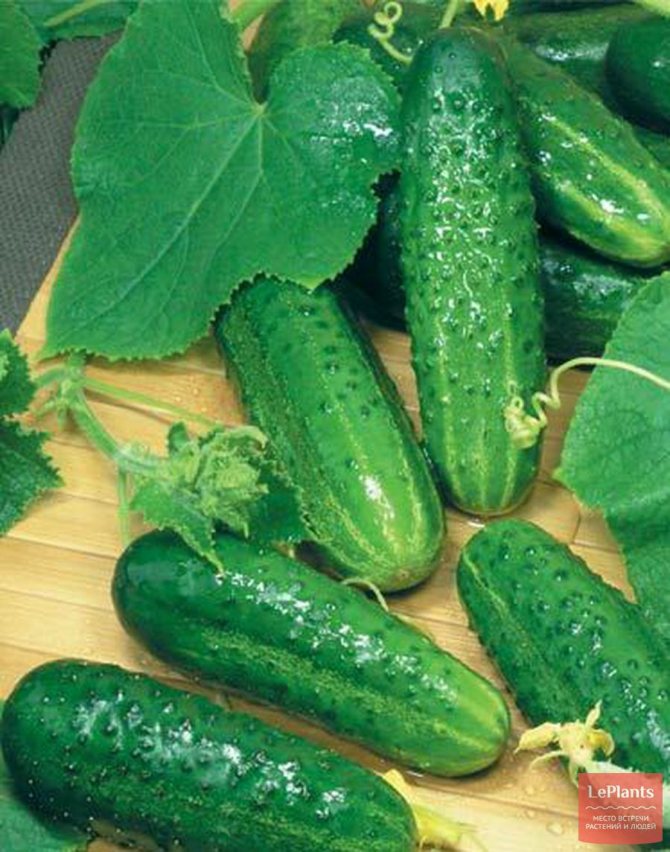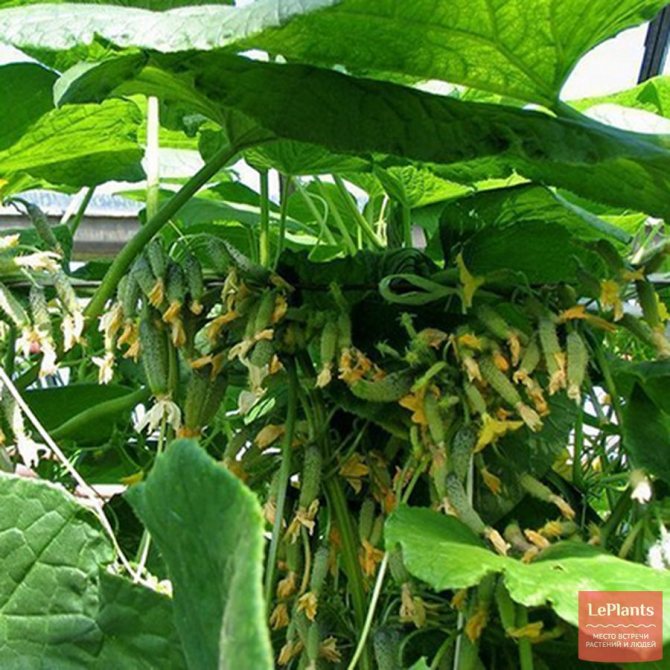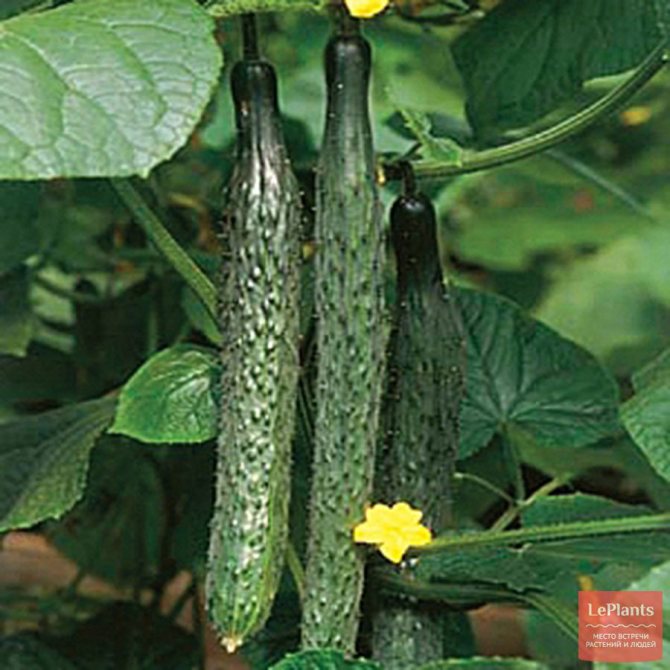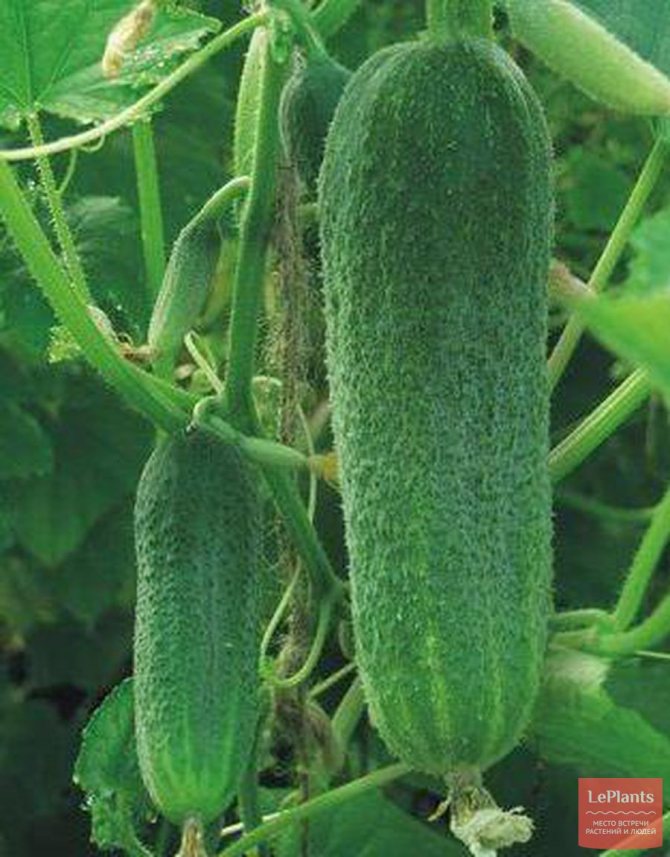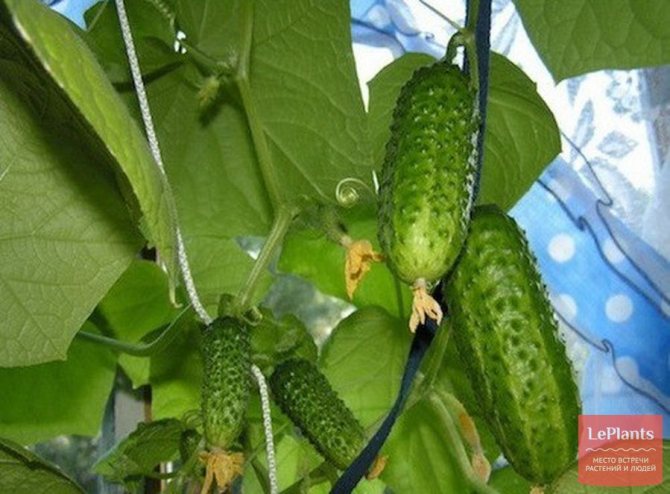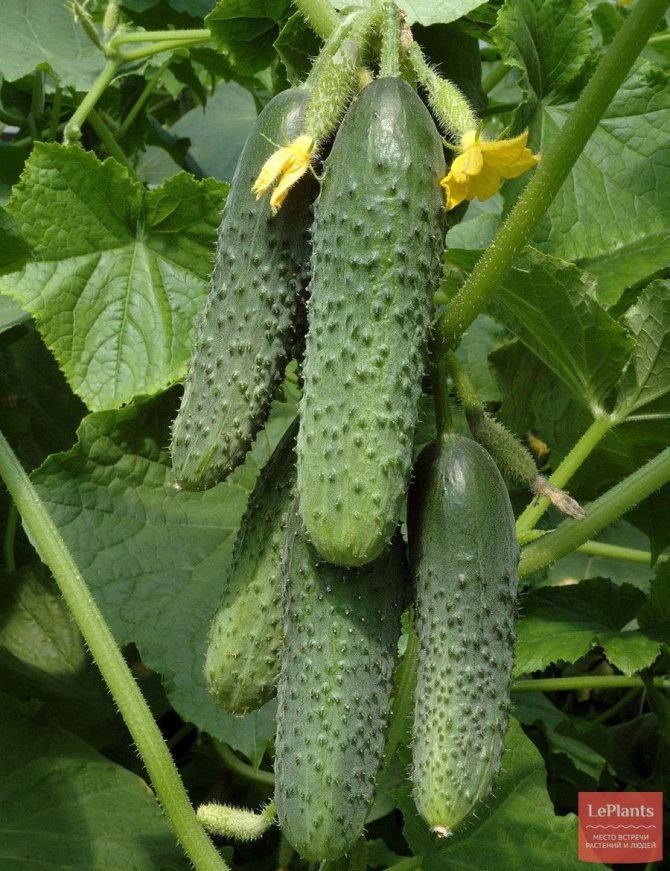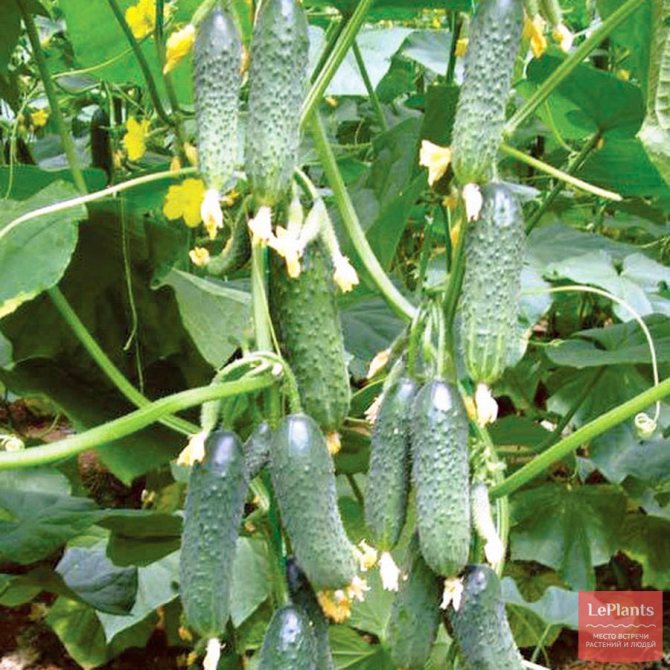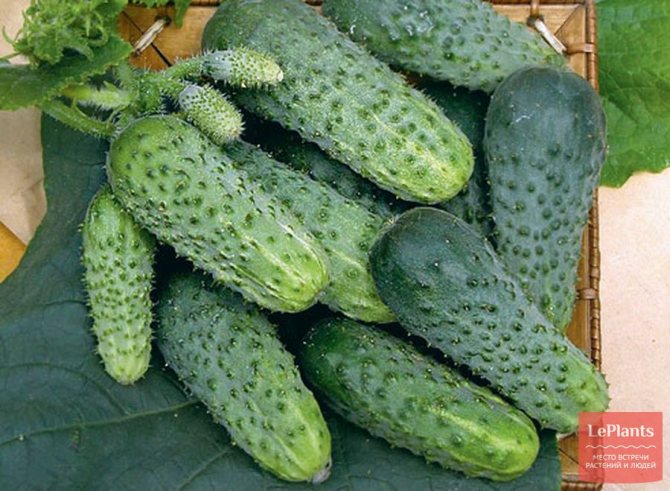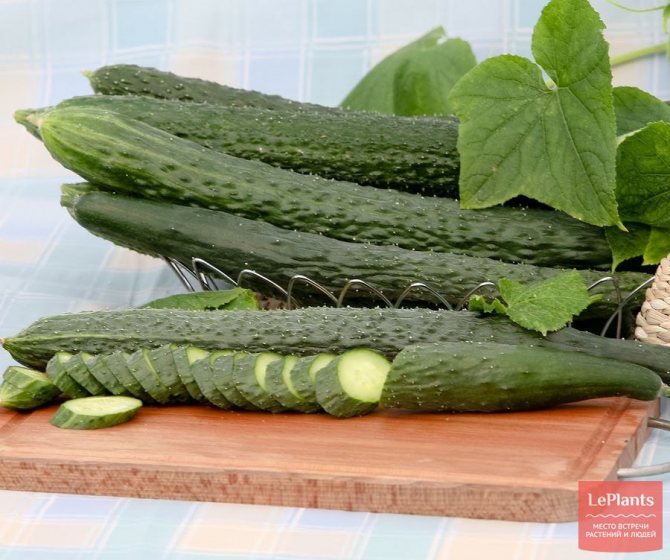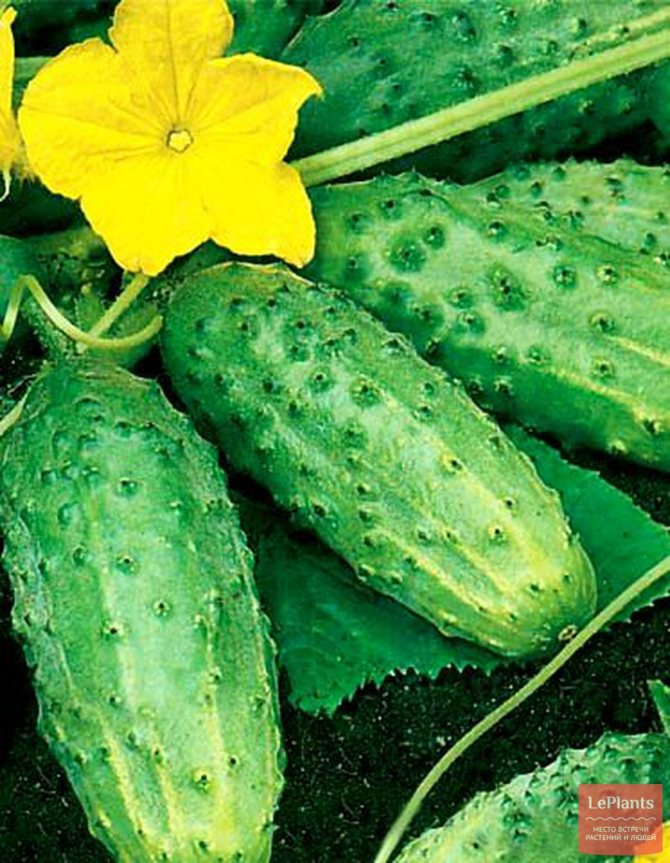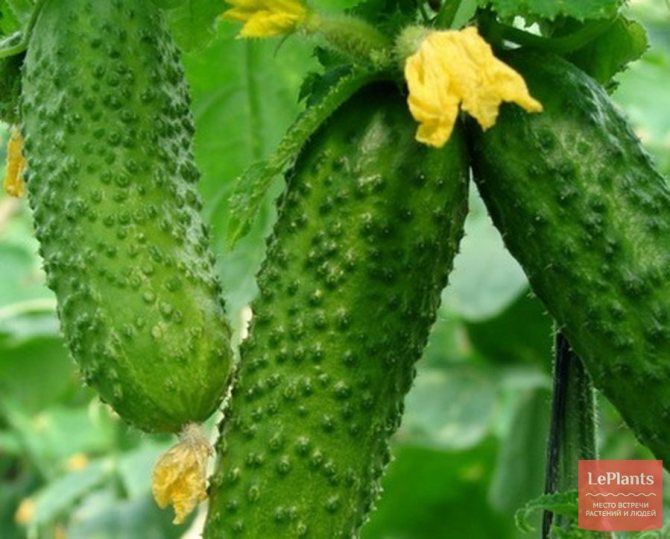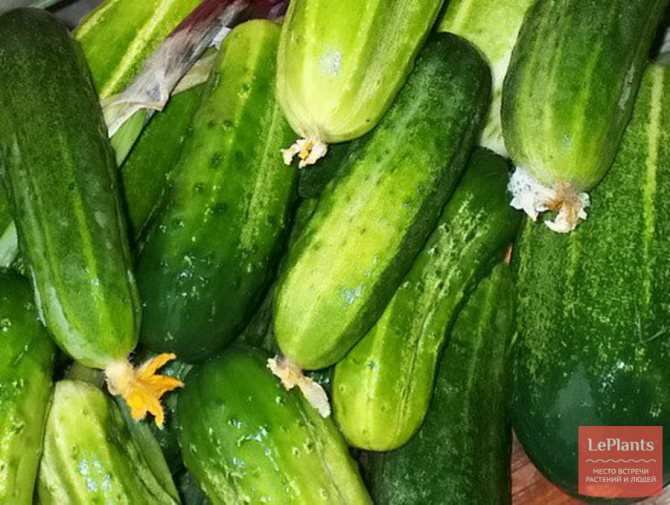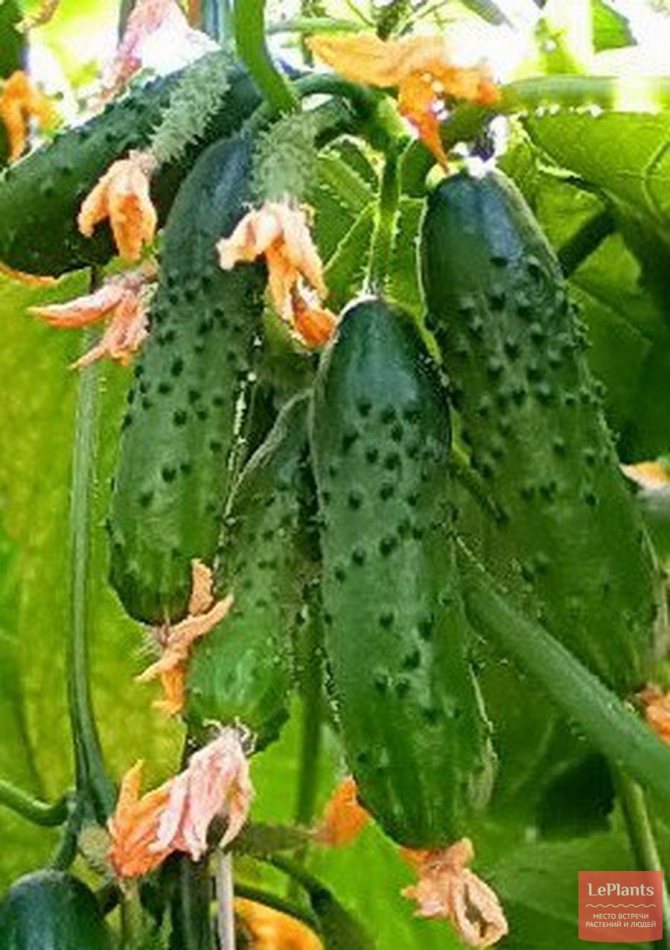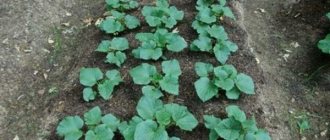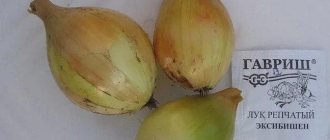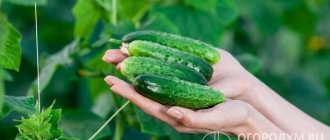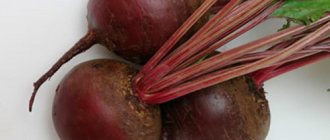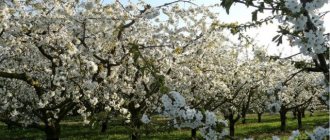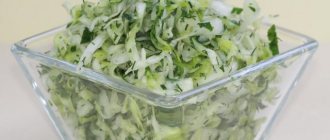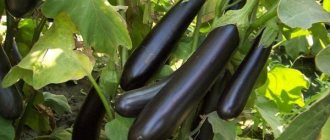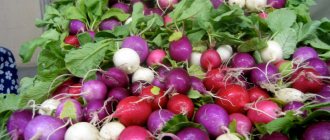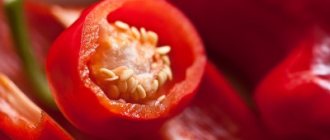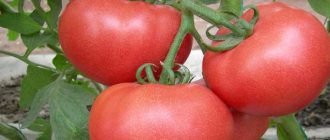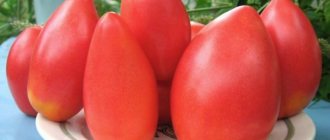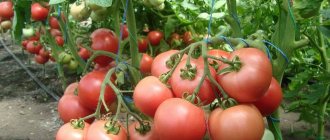Climatic conditions of the region
The Moscow region has a temperate continental climate. Spring is cool, so the ideal time for planting crops in the garden comes only at the end of May. The air temperature should warm up to 15 degrees Celsius, soil - up to 10 degrees. It often rains in summer. The average summer temperature is 18 degrees.
In the Moscow region, cucumbers can be grown using pre-prepared seedlings or by the seedling method. Seeds for seedlings are sown in early May. Before being transferred to the garden, the seedlings should be 20-25 days old, they should grow up to 15 centimeters.
At the end of May, you can sow seeds directly into the garden. True, fruiting will occur 1-2 weeks later than with the seedling method. But the plants will grow stronger and more adapted to the climate of the Moscow region.
Self-pollinating varieties of cucumbers - concept and advantages
Very often, the concept of self-pollinated is understood as varieties of cucumbers that do not need pollination by bees or other plants. In fact this is not true. Two varieties of cucumbers at once do not need the participation of bees or other insects in the formation of fruits, namely:
parthencarpic cucumber varieties (self-fertile). They do not need pollination at all, so there are no seeds in their fruits;
self-pollinated varieties of cucumbers. They have both a pistil and stamens in their flowers, that is, they are absolutely self-sufficient. The pollination process takes place within the framework of one plant, and the fruits, which quite naturally, have seeds.
Parthenocarpic and self-pollinating varieties are in many ways similar in terms of the techniques and methods of agricultural technology used in their cultivation, as well as the advantages they have.
What are the advantages of these varieties of cucumbers, because of the presence of which they are so widespread?
Firstly, these varieties are ideal for growing in greenhouses and greenhouses, where it is not always possible to provide free access to bees. This greatly simplifies, in comparison with bee-pollinated varieties, their cultivation, since there is no need for a special attraction of insects.
Secondly, and this is more important for the topic of this article, parthenocarpic and self-pollinating varieties are the best suited for open ground in central Russia and even more northern regions of the country. The fact is that the number of sunny and warm days, when bees are most active, in these regions is small. Therefore, an important plus is the ability to bear fruit on cold and cloudy days. This is what distinguishes the self-pollinating varieties of cucumbers, which have long been recognized as the best for central Russia.
Requirements for varieties of cucumbers
Early, middle and late varieties are grown in the Moscow region. Rapidly maturing crops can be planted twice - at the end of May and at the end of June. Cucumbers will ripen after 38-40 days. With such agricultural technology, the crop can be harvested the whole summer. Late varieties ripen 45-65 days after planting. In order to protect the plants from the vagaries of the weather and get an excellent harvest, it is advisable to build a low film greenhouse in the garden.
- does not need pollinators;
- resistance to fungal diseases;
- early ripening of the crop;
- cold resistance;
- high yield rates.
For the Moscow region, it is advisable to purchase hybrid and varietal crops specially created for this region. Self-pollinated and insect-pollinated varieties are grown in this area. Ideal for the Moscow region - an early self-pollinated hybrid.
The best varieties in terms of yield
Every summer resident certainly wants to get hold of the most prolific vegetable plant. What varieties of cucumbers are the most productive, you can find out from our review below.
Early
If you want to achieve high yields - at the level of 11-17 kg of cucumbers per 1 sq. m, then you need to choose such early maturing varieties and hybrids as:
- F1 White Night;
- "Pinocchio F1";
- "Summer Resident F1";
- "Dasha F1"
- "Emelya F1";
- "Strongman F1";
- "Kustovoy";
- "Cellar F1".
Of the listed vegetable plants, Pogrebok F1 brings the highest yield.
Average
Excellent fertility is also characteristic of some mid-season cucumbers, for example:
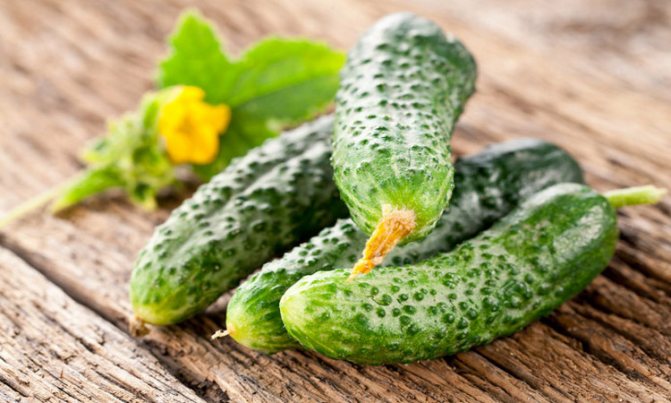
Late
With their fruiting, late-ripening specimens will certainly delight the owners of gardens and greenhouses:
Important! In order for a vegetable plant to give a good harvest, choosing just the right variety will not be enough. The cucumber also needs to create optimal conditions for it.
The best cucumber crops for the Moscow region in terms of ripening
On the territory of the Moscow region, you can grow early, medium and late cucumbers. It is advisable to plant several different varieties in your garden.
Early maturing varieties
Early vegetables are grown to make light vegetable salads. Some varieties are used for salting and preservation. Cucumbers ripen at 38-40 days.
Dmitry Donskoy F1
Parthenocarpic, early maturing hybrid. The crop is harvested after 40 days. Vegetables are grown for salads, they have a smooth skin, no thorns. Ripe vegetables have a mass of 100 grams, a length of 13 centimeters, and a thickness of 3.2 centimeters.
Mother-in-law dessert F1
An early maturing hybrid that does not need pollinating insects. The crop is harvested after 39 days. The ovaries are laid in bunches, 3-4 fruits in each. Vegetables have a small number of spiked tubercles. Weight - 103 grams, length - 10.5 centimeters.
Mid-season crops
Plants with a medium ripening period. Begin to bear fruit after 45-50 days. It is preferable to grow seedlings. Cucumber seeds are sown in late April or early May. The seedlings are transferred to the garden at the end of May.
Lucky F1
Hybrid indeterminate culture. Requires pollination by bees. Grown for the preparation of summer salads and for conservation. The weight of the vegetable is about 115 grams, the length is 12 centimeters. The taste is good, without bitterness. There are tubercles with thorns on the skin. One plant can produce about 6-9 kilograms of vegetables.
Filippok F1
Hybrid culture. Ripe vegetables are 6-8 centimeters long and weigh about 70 grams. These are pickled vegetables. Cucumbers can be eaten fresh or prepared for the winter. Vegetables are small, lumpy, crispy, without bitterness. All cucumbers are the same size.
Actor F1
Hybrid gherkin culture. The crop can be harvested in 50 days. Ripe vegetables are 8 centimeters long and weigh 80 grams. On the surface of the cucumbers there are a small number of small tubercles with thorns. The plant perfectly tolerates the vagaries of the weather. Up to 9 kilograms of harvest are harvested from one stem.
Late ripening cucumbers
Late varieties of cucumbers begin to bear fruit after 50-65 days. The crop is harvested from July until the first frost. Late-ripening cucumbers do not need shelter. Plants perfectly tolerate the vagaries of the weather, rarely get sick. The most popular varieties: Nezhinsky, Nerosimy 40, Rodnichok, Kapelka, Phoenix, Pobeditel, Courage, Brownie.
Nezhinsky
Sometimes this variety is called Little Russian. The crop can be harvested only after 50-65 days. The plant has a long stem (2 meters) that requires support. The culture needs pollinators. Ripe vegetables - plump, 10 centimeters long, weighing 100 grams.There are rare tubercles on the surface. The culture bears fruit abundantly, rarely gets sick. It is ideal for pickling.
Droplet
Pollinated by bees culture. The crop can be harvested after 60 days. From one plant, you can get about 10 kilograms of vegetables for pickling. Ripe cucumbers are 11 centimeters long and weigh 105 grams. The pulp is not bitter. The plant bears fruit until the first frost.
The best varieties by region
Russian breeders have tried to breed many varieties and hybrids that are suitable for cultivation in harsh (for cucumbers) conditions.
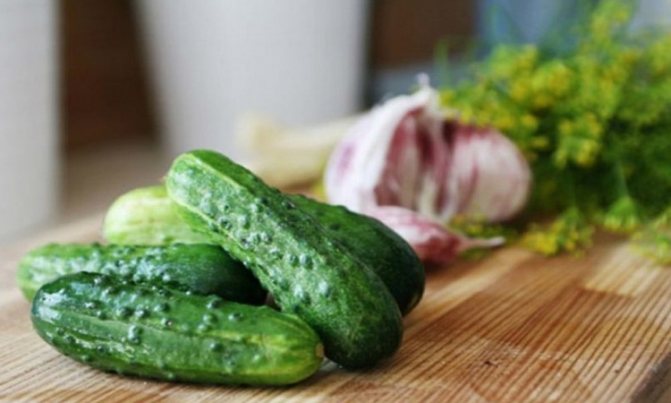

For Moscow and Moscow region
For Moscow and the Moscow region, early varieties of cucumbers are best suited. All of them, without exception, should be planted in seedlings, first growing seedlings in a room with a warm temperature or planting them in a greenhouse.
Summer residents from this region can recommend the five hybrids listed below. Please note that they are always marked with the letter "F". We list the hybrids not according to their popularity, but alphabetically.
- "April F1". An early ripe hybrid that ripens in 49-53 days. Produces fruits weighing up to 250 g and 18-20 cm long. It can grow in the open air and in protected ground. Designed for salads. His immunity to disease is average. In the garden, the yield is about 6 kg / sq. m.
- "Aquarius F1". Medium early variety. Fruits in 55-60 days with green fruits up to 14 cm in size and weighing up to 120 g. It is grown for salads and pickling. Suitable for garden cultivation.
- "Shrub F1". Vegetables ripen early. They weigh up to 120 g, in length - 10-12 cm. The cucumber is planted in an open area. In cooking, it is used wherever a green vegetable can be used.
- "Masha F1". The yield of the hybrid is 10-11 kg / sq. m. Early ripeness - on the 36th day. Fruits 8-11 cm long, weighing 100 g. Purpose - universal. The advantage is resistance to major cucumber ailments. Planting - in shelter and in the garden.
- "Goosebump F1". Brings vegetables 10-15 cm long and weighing 80-100 g. Fruits in 43-48 days after sprouting. The landing site is open and sheltered areas. Thanks to delicious fruits in any form, the variety has found universal fame.
Did you know? Translated from Greek, "cucumber" means "unripe".
For the middle lane
The five most suitable varieties of cucumbers for growing in the Middle Lane look like this:
- "Stork". Mid-season universal variety (49-52 days). Vegetables 9-14 cm long, weighing 70-100 g. It is grown in open areas and under a film.
- "Unity". It is characterized by mid-ripening, generous harvests, disease resistance, large fruits. The purpose is universal.
- "Moscow Nights". A universal representative, characterized by high productivity, early ripeness (42-45 days), large fruits (14 cm, 110 g), disease resistance (powdery mildew, mosaic).
- "Spring F1". Medium ripening hybrid. It is used for winter blanks. Fruits with cucumbers 12 cm long and weighing 100 g.
- "Phoenix". A variety with an average ripening period, excellent taste characteristics and large fruits (15-16 cm, 180 g).
The best self-pollinated outdoor cucumber hybrids
Such crops do not need special care. Plants need to be provided with regular watering, top dressing on time, and weeds that have appeared nearby. One flower of such crops has pistils and stamens. Cucumbers pollinate on their own, without insects, creating seeds with seeds.
Early crops have a juicy and tender flesh. Late self-pollinated varieties are denser and ideal for conservation. Rating of the best varieties: Herman, Claudia, Alliance, Orpheus, Zador, Connie, Muromets, Masha, Gerda; gherkins - Alex, Melody, Opera.
Herman F1
Hybrid early variety. Cucumbers are tender, without bitterness.Suitable for vegetable salads and pickling. Ripe vegetables are 12 centimeters long and weigh 95 grams. Up to 9 fruits can form in one ovary. The culture rarely suffers from late blight.
Alliance F1
A hybrid that ripens in 50 days. The culture bears fruit abundantly. A ripe cucumber is 15 centimeters long and weighs 125 grams. 6 fruits can grow in one bunch. It is advisable to germinate the seeds before planting. An ideal variety for conservation.
Popular yielding varieties
The most productive crops can yield from 9 to 15 kilograms of vegetables from one bush. Such plants are often indeterminate, hybrid, self-pollinated, or parthenocarpic.
Salad crops
For salads, early varietal or hybrid crops with thin skin and excellent taste characteristics are grown. Such cucumbers should be juicy, crispy, sweetish, without bitterness. The length of the salad cucumbers is from 12 to 27 centimeters. Popular varieties: Zozulya F1, April F1. Ripe vegetables weigh 150-250 grams.
Openwork F1
An early maturing hybrid that does not require pollinators. Vegetables are ripe for 45 days. The length of one cucumber is 11 centimeters, weight is 100 grams. Ideal culture for preservation and salads. One plant can be harvested 10.5 kilograms. The culture rarely suffers from cucumber mosaics and powdery mildew, it perfectly tolerates the vagaries of the weather.
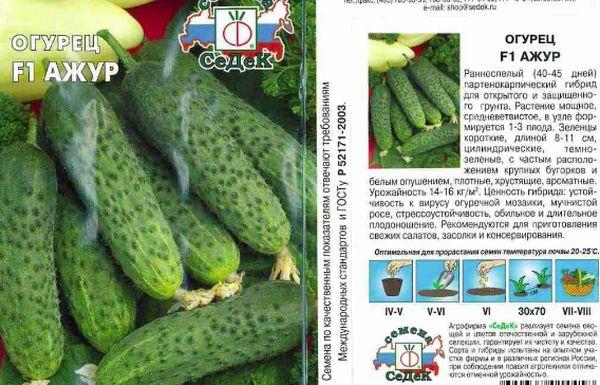

Avoska F1
An early maturing hybrid that does not require pollinating insects. The crop can be harvested in 43 days. It is possible to collect 13 kilograms of vegetables from one square meter of area. The length of ripe fruits is 11-14 centimeters, weight is 135 grams. Vegetables do not have bitterness, voids and yellowish spots. The culture rarely gets sick, it perfectly adapts to the climate of the Moscow region.
Beethoven F1
Hybrid plant. Begins to bear fruit after 44 days. The length of ripe vegetables is 8-10 centimeters, weight is 80 grams. Cucumbers are eaten fresh and used for preservation.
Bourgeois F1
A hybrid that does not require pollinators, with long, smooth fruits with almost no thorns. The culture bears fruit already on the 45th day. Mature vegetables are 20 centimeters long and 200 grams in weight. An early salad variety. One plant can give about 10 kilograms of harvest.
See also
How to water cucumbers in a greenhouse and open ground, terms and rates of water consumption
To read
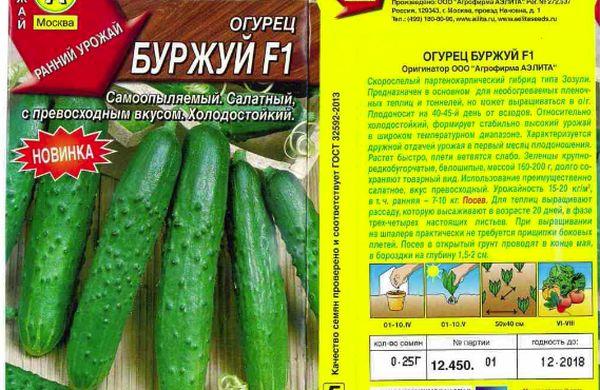

Varieties for conservation and salting
For harvesting for the winter, medium or late varieties are suitable. These vegetables ripen in the second half or at the end of summer. They have a dense and crunchy flesh, no bitterness, perfect shape, excellent taste.
Vivat F1
Indeterminate early hybrid culture. Ripe cucumbers are 10 centimeters long and 3 centimeters in diameter. The fruits do not outgrow. Ideal for conservation.
Atlantis
Dutch hybrid, ripening on the 50th day. The mass of vegetables is 120 grams, length is 12 centimeters. The pulp is not bitter.
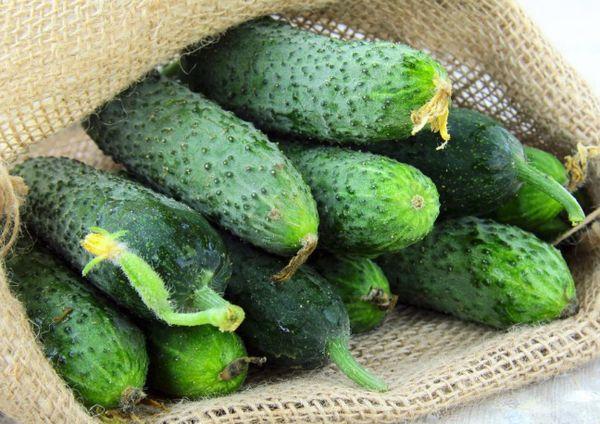

Day F1
A bee-pollinated hybrid maturing at day 55. Cucumber length - 8 centimeters, weight - 80 grams.
Baba Masha F1
A hybrid requiring pollinators. Ripens on day 40. Mature vegetables are 8-10 centimeters long and weigh 85 grams.
Features of planting and caring for cucumbers in the Moscow region
Cucumbers do not tolerate transplanting well, do not need diving. For seedlings, it is advisable to use peat pots, which, together with grown seedlings, can be transferred to the garden. Soil for seedlings is pre-fertilized with organic and mineral substances. You can buy ready-made soil mixture immediately.
Before planting, the seeds are disinfected in a weak solution of potassium permanganate. Cucumber seeds are kept in it for no more than 30 minutes. Some hybrid seeds are sold directly treated with growth promoters. Such seed does not need additional processing.
Seeds germinate 2-4 days after sowing. Seedlings are placed in a well-lit place.Every day, turn the pots of seedlings so that they do not stretch to one side. It should be constantly monitored so that the earth does not dry out. It is necessary to water the seedlings regularly. Before transferring to the garden, it should take about 20 days. The seedlings should have 4 real leaves, they grow up to 15 centimeters by this period.
Before transplanting to the garden, the seedlings are hardened. Every day, the seedlings are taken outside for several hours so that they get used to the climate. Seedlings are transplanted at the end of May. At the same time, you can sow seeds directly on the garden bed. After sowing seeds in the garden, each hole is covered with plastic bottles with a cut-off bottom. To obtain a guaranteed harvest, it is advisable to plant several varieties of cucumbers.
It often rains in the Moscow region. To eliminate stagnant water, it is advisable to make high beds for cucumbers. Previously, the earth is dug up, loosened, fertilized with organic matter and minerals. 1 bucket of rotted humus, 40 grams of superphosphate, 40 grams of potassium sulfate, 500 grams of wood ash are introduced per 1 square meter of the site.
Cucumbers are planted in specially prepared holes, usually in 2 rows. The distance between plants should be 35 centimeters. Between rows - 50 centimeters, between adjacent beds - about 1 meter.
It is advisable to tie the grown plants to the support and direct them up. This method guarantees a higher yield, vegetables do not rot, and the crop receives enough sunlight. As a support, you can use wooden pegs, a cucumber trellis plastic net.
During the growth period, the plants are regularly watered. It is advisable to use rainwater for irrigation. Cucumbers are watered every other day. To increase yields, it is important to apply top dressing to the soil. The first time the cucumbers are fertilized 2 weeks after planting. For feeding, liquid organic or nitrogen mineral fertilizers are used. During the period of ovary formation, phosphorus and potassium additives are added to the soil.
The stem of an indeterminate variety must be pinned, and after reaching the height of the trellises, pinch the top. Bushy determinant crops do not need formation and pruning. Such plants form a low bush with many shoots on which fruits develop.
Vegetables are harvested regularly as they ripen. The best time to harvest is early morning or late evening. In a cool room, the harvested vegetables can be stored for 2 weeks, in a warm room for about 3 days. Cucumbers are eaten fresh, used for pickling and canning.
Main advantages and disadvantages
Bunch cucumbers have many undeniable advantages:
- Stable, high yield without the formation of "overgrown". On average, the yield is 10 kg per bush.
- Mass maturity.
- Compact dimensions for canning.
- Stable immunity to diseases.
- Tolerance to temperature drops.
- Early maturity... The appearance of the first cucumbers after 38-40 days, even after 35 - depending on climatic conditions.
- Ideal taste qualities and versatility of use, well kept.
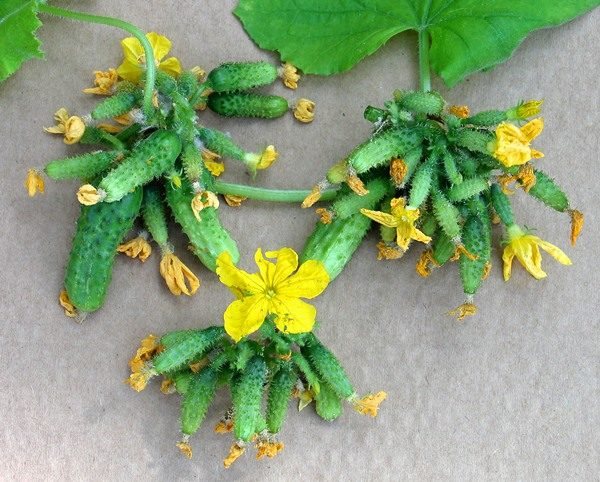

Bundle arrangement of cucumber ovaries
Conditional disadvantages include the need for frequent fruit collection for the full maturation of new ones. This inconvenience will affect mainly summer residents who are not able to visit the site every day. They need to pay attention to varieties that are less demanding to care for.
How to make the right choice
To make it easier to navigate in a huge variety, it is recommended to select varieties:
- zoned for your region;
- that interest you (for a greenhouse or vegetable garden);
- taking into account the purpose (for salads, pickling, universal) and the ripening period;
- resistant to low temperatures, diseases and pests.
Then, according to the selected varieties, you should study the information on yield, size, weight and taste, and then finally decide on the choice.
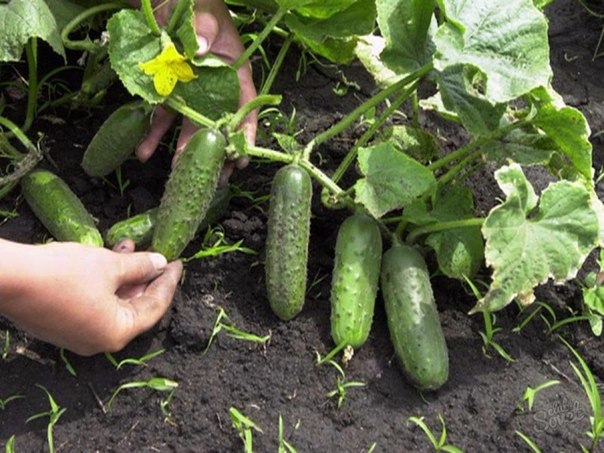

In order for cucumbers to please with high yields and delicate taste, it is recommended to take into account a few more tips:
- it is desirable to purchase hybrids;
- it is better to buy seed that is sold by domestic producers;
- you should go to the shops where the seeds are sold;
- carefully study the label, which provides information on the date of manufacture and expiration date.
Variety selection: basic requirements
Today, the choice of varieties and hybrids of cucumbers is very large - there are several thousand approved for use in the Russian Federation. It is quite difficult for summer residents and gardeners to understand this variety. We suggest using our tips on how to choose cucumber seeds.
First you need to find information about which seeds of which varieties are suitable for cultivation in your region of residence. Then select them depending on the conditions in which you plan to grow greenhouses - in a greenhouse, a greenhouse, or just in the garden.
It is important to understand that ground vegetables are usually tastier than greenhouse vegetables. You can read about the seeds that are best suited for the first and second cases in a separate section.
You also need to think about which month you would like to have fresh vegetables on your table - having decided, choose a variety depending on the ripening period.
Next, you should inquire about the resistance of the varietal sample to diseases and low temperatures.
In conclusion, you should take an interest in what varieties of cucumbers are best suited for the purpose of growing - for fresh consumption, for pickling or for universal use.
So, by cutting off varieties that are unsuitable for your conditions and purposes, you can greatly narrow the number for selection. Further, it is already possible to apply criteria such as yield, size, taste for selection.
All these requirements are tested by the State Breeding Register and are usually written by producers on the seed packaging.
Did you know? The largest cucumber listed in the Guinness Book of Records was obtained by the Englishman Alfo Cobb. Its length was 92 cm.
Below we have selected for you an overview of the best varieties of cucumbers in each of the categories:
- by region;
- by the rate of maturation;
- by crop volume per 1 sq. m;
- by the way of use;
- according to growing conditions.
What varieties are grown in the Moscow region
According to reviews, the best varieties of cucumbers for the Moscow region:
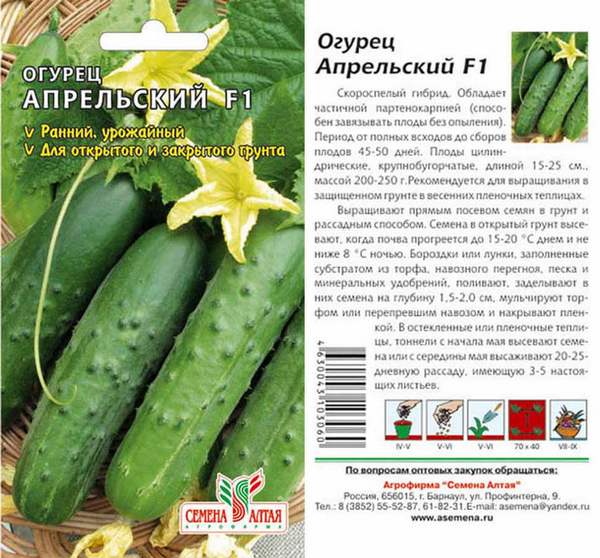

By ripening period
All varieties of cucumbers, depending on the ripening period, are divided into early, medium and late. It should be noted that in the northern regions, you need to sow early vegetables, and for the southern regions, any.
Early ripe
You can enjoy the taste of cucumbers within 30-40 days after germination.
Especially popular among gardeners are:
- Altai early;
- Cupid (ultra early);
- April;
- Pinocchio;
- Hermann;
- Zozulya;
- Cascade;
- Connie;
- Competitor;
- Courage;
- May;
- Tom Thumb;
- A summer resident's dream;
- Moscow dude;
- Muromsky 36;
- Finger;
- Moscow Nights;
- Five Stars;
- Fontanelle;
- Cornucopia;
- Company's secret;
- Khutorok;
- Gypsy;
- Ecole.
Mid-season
Maturity occurs in 40-55 days.
The best mid-season varieties:
- Alliance;
- Athlete;
- Babayka;
- White angel;
- Zozulya;
- Libelle;
- Nezhinsky;
- Topolek;
- Unity;
- Solar;
- Son of the regiment;
- Claudia;
- Connie;
- Competitor;
- Kuzya;
- Lohengrin;
- Picas;
- Raphael;
- Fontanelle;
- Svyatogor;
- Phoenix plus;
- French size;
- Ecole.
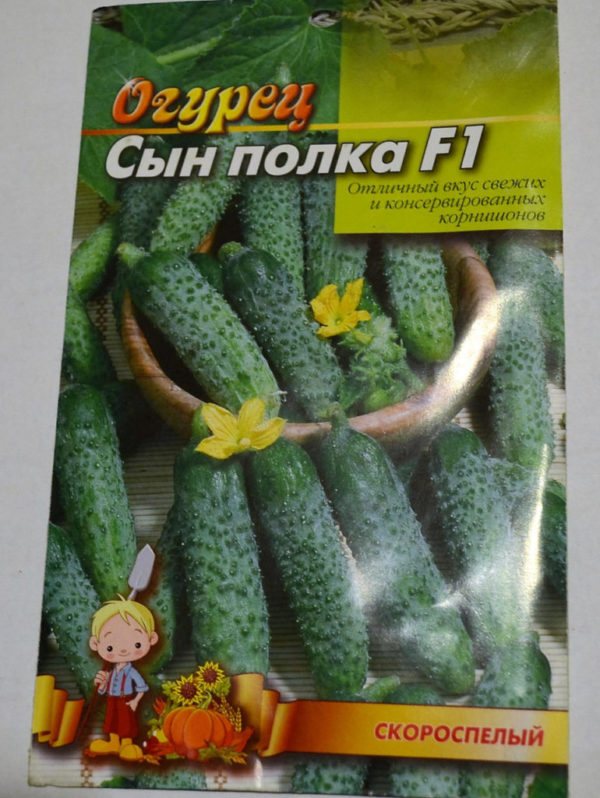

Late ripening
Ripen for 60-80 days.
Good recommendations received:
It should be noted that the time that passes before ripening may vary depending on the quality of the seeds, the planting site (greenhouse or open ground), soil composition, temperature, watering.
Best in cooking method
In cooking, the green vegetable is used for three purposes:
- for salads;
- for canning;
- for salting.
Summer residents noticed that there are varieties and hybrids of F1 cucumbers that are suitable for one of these purposes, or they have a universal purpose. Based on the advice of those who grow vegetables with their own hands, we have compiled small ratings of the best specimens by cooking method.
For salting
So, according to the reviews of summer residents and gardeners, the best varieties of cucumbers for pickling are the ones we have already described above, "Masha", "Murashka", "Zyatek", "German". And also "Rodnichok", "Libelle", "Monastyrsky", "Graceful", "Muromsky", "Nezhinsky", "Cascade".
They are good in taste, which can be preserved even when salted. They are distinguished by a dense skin and the presence of thorns on the skin.
For salad
Fresh dishes include Bazar F1, Bukhara F1, Zozulya F1, Kochubei F1, Makar F1, Marta F1, Tamerlane F1.
The fruits of these varieties, as a rule, are large, beautiful in appearance, with a smooth, polished surface, thin skin, and sweet taste. They become soft when pickled.
For canning
The following varieties of cucumbers are suitable for canning: "Magnificent", "Erofey", "Graceful", "Cascade", "Competitor", "Movir", "Muromsky", "Nezhinsky".
For canning, select small cucumbers, crispy when bitten.
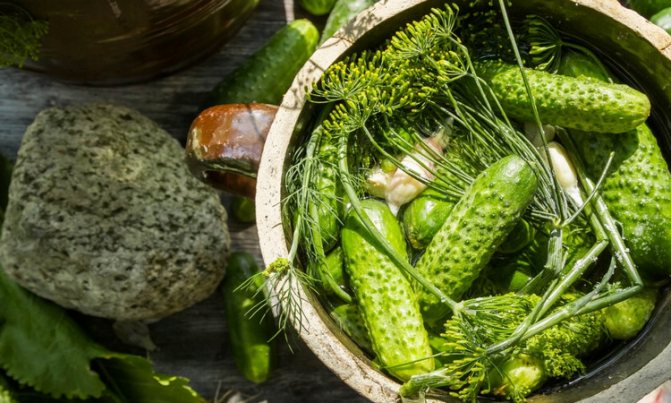

Universal
The universal cucumbers include: "Aist", "Beregovoy", "Vostok", "Vyaznikovsky 37", "German F1", "Courage F1", "Kustovoy", "Libelle", "Moravian Gherkin F1", "Phoenix 640" ...
All-purpose cucumbers usually produce small yields.
Important! Varieties should be renewed every three to five years, as their yield becomes weaker after such a period.
Choosing a cucumber variety is an important step in growing this vegetable. Plants correctly selected according to various criteria are a guarantee of a successful harvest.
When choosing, we also recommend using the following recommendations:
- give preference to hybrids;
- refuse to buy seeds from foreign producers;
- buy seed from a reputable manufacturer and in a specialized store;
- when purchasing, read the information on the label on the date of issue, batch number and expiration date.
All these recommendations will allow you to avoid purchasing low-quality goods and disappointment from a failed harvest. And now you already know which varieties are the best, depending on the region, yield, planting method and use.
Preparatory work
In order for the cucumbers to feel comfortable and give high yields, it is necessary to prepare a plot for them (best in the fall):
- choose a place well-lit by the sun and protected from northerly winds;
- dig up the soil and apply fertilizer;
- equip a bed on a dais;
- every 2-3 years the site should be moved to a new location.
Soil preparation
To make a high bed, you must:
- To the size of the proposed bed, dig a hole to a depth of 20-25 centimeters.
- Along the perimeter, fence the site with slate or boards to a height of 20-30 centimeters.
- Fill the box with soil prepared from black soil, humus, peat and sand, taken in a ratio of 3: 1: 1: 1. Add 1-2 kilograms of wood ash and 50-60 grams of superphosphate for each square meter.
But it is better to prepare a warm bed, for which 3 layers 10-15 centimeters thick are placed in the box:
- the first layer - sunflower or corn stalks, tree branches, boards;
- the second layer - shavings, wood chips, small twigs;
- the third layer - leaves, hay, sawdust.
From above, black earth is covered with a layer of 5-7 centimeters. The bed is well moistened. It is advisable to add products that contain soil bacteria.
Diseases and pests
| Powdery mildew Symptoms:
Treatment:
|
| White mosaic Symptoms: On the leaves, along the veins, star-shaped white specks with a yellowish halo appear. Over time, the leaf whitens completely. Treatment: Helps the drug Extrasol |
| Olive spot or Cladosporium Symptoms: Dark brown spots appear first on the fruit, after which the cucumbers wither and curl up. Small brown spots also appear on the leaves. Treatment: Spraying with copper chloride (HOM) or Bordeaux liquid |
Seed preparation
Growers often sell seeds already prepared for sowing. They are covered with a bright shell, which contains nutrients.
If unprocessed seeds are taken for sowing, then they need to be prepared. First, you should discard unsuitable seeds. To do this, the seed is placed in salted water (a teaspoon of salt is needed for a glass of water) for half an hour. During this time, seeds unsuitable for sowing will rise to the surface, and high-quality seed will sink to the bottom.
To increase yields, methylene blue (0.3 grams of powder per liter of water) can be added when soaking. For disinfection, the inoculum is treated with a solution of potassium permanganate.
To speed up germination, the seeds are soaked and kept warm until they hatch.
Features and rules of cultivation: cucumber ovary and fruiting
The process of growing bunch cucumbers in the open field is similar to growing conventional varieties, but there are some nuances.
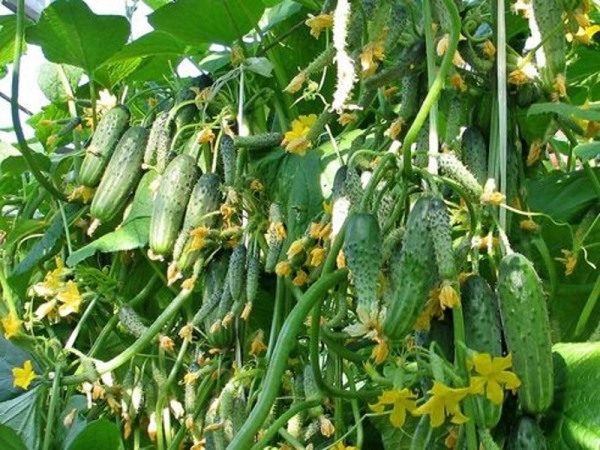

Harvest of bunch cucumbers
If the plant is weak and unable to provide a large number of ovaries with nutrients, then they begin to dry out and fall off. To avoid such a situation, we follow the following rules:
- One week before landing add 10-15 kg of compost to the finished bed and 30-40 g of complex mineral fertilizer per 1 m2. Digging up.
- The day before planting seedlings we spill the garden well. We plant at a soil temperature of +10 degrees at a depth of 10 cm.
- We disinfect each well liter of warm pink potassium permanganate solution.
- We plant seedlings in a row every 40-50 cm, since all bunch cucumbers do not like crowding. We mulch with humus.
- Installing the trellis, better with mesh. We form a bush in a timely manner and pinch the side branches for the appearance of ovaries.
- We shape it in a special way. We remove all flowers and processes in the axils of the lower 4 leaves. You do not need to touch 2 lateral shoots with ovaries, pinching them. We pursue the task - to achieve the maximum harvest from the main stem.
Growing seedlings
For sowing seeds for seedlings, mix in equal proportions humus, peat, turf soil and river sand. For each bucket of prepared soil, add 500 grams of wood ash and 50 grams of superphosphate. You can also purchase ready-made primer in a specialized store.
It should be noted that diving and transplanting are very difficult for cucumbers. Therefore, it is better to sow seeds in peat pots or tablets. If the seedlings are grown in plastic cups, then they are transplanted by the transfer method.
The optimal volume of cups for seedlings is 200-250 milliliters. Small holes are made in their bottom for drainage. 2-3 seeds are sown in one glass, deepening them by 1-2 centimeters. The containers are covered with foil until shoots appear.
Seedlings must be illuminated for 12-14 hours daily. With a lack of lighting, the seedlings will stretch out and die. It is best to purchase phytolamps that emit light waves of the spectrum necessary for plants. But in their absence, you can use fluorescent lamps or "housekeepers".
For irrigation, use settled water at room temperature, best of all - rain or thawed. You shouldn't water the soil too much, but you shouldn't let it dry out either.Usually the seedlings are watered 2 times a week. Periodically, the earth is loosened.
If the seedlings are planted in properly prepared soil, then they do not need feeding.
A few days before planting in open ground, the plants need to be hardened. To do this, they are taken out into the street.
Description of bunch cucumbers
Bunch cucumbers belong to the pumpkin family. It is an annual plant with a stem up to 2 m long. The type of fruiting, called bunch or bouquet, resembles bunches of mini-bananas. Fruits are small - gherkins or pickles. Pollination type hybrids can be parthenocarpic and bee-pollinated. Almost do not form barren flowers. Very light-requiring.
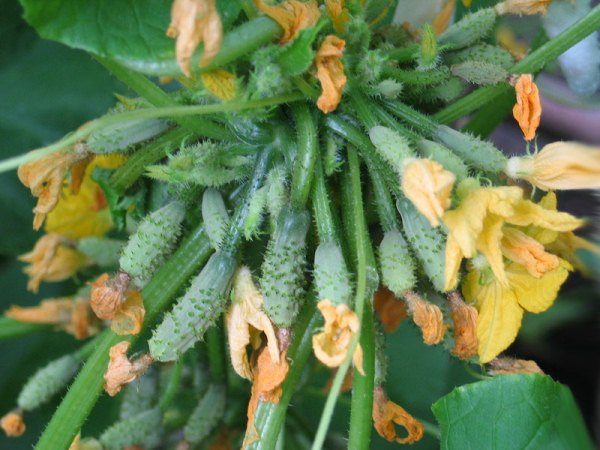

Ovary of bunch cucumbers
They are divided according to the type of branching into:
- Strong... The most productive, but laborious to care for. Has a long growing season;
- Average... The yield is slightly lower due to the shorter fruiting period;
- Weak... Almost do not form lateral processes, do not need pinching. The growing season is short, the yield is slightly lower than that of the previous types. Doesn't require painstaking care.
Landing
Planting can be done in rows or in a square-nesting manner, which is more preferable. The seeds are buried in the soil to a depth of 3-5 centimeters.
When square-nesting method, pits for plants with short lashes are made at a distance of 70 centimeters, and with long ones - at a distance of 90 centimeters. 2-3 seeds are placed in one hole.
When trellis methoduse a two-line scheme. Make 2 rows at a distance of 40-50 centimeters, leaving a half-meter passage between them. Plants are planted in a row at a distance of 20-40 centimeters.
If seedlings were grown, then they should be planted in the ground at the age of 25-30 days. It is advisable to choose cloudy weather for planting. If it is sunny days, then you should start landing work in the evening. A handful of ash or humus is placed in each hole. After planting, the bushes are well watered.
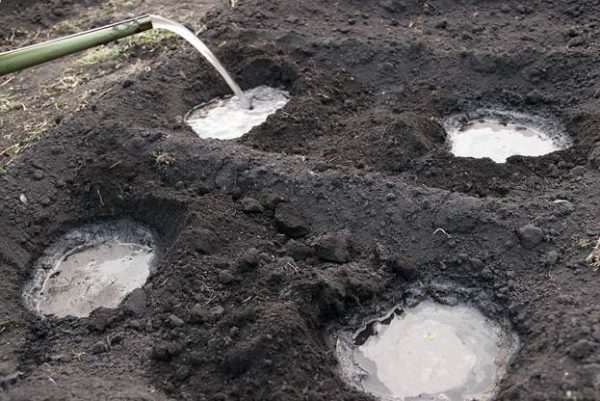

Transplanting.
When to plant
There is no exact date for sowing cucumbers. The disembarkation time is determined by weather conditions. The air should warm up to 18 ° C (the night temperature should not drop below 8 degrees), and the soil should be up to 10.
In the Moscow region, the optimal time for planting is usually no earlier than mid-April.
Sowing seeds for seedlings is carried out at the end of March. The lunar calendar 2020 will help you choose the best dates for sowing seeds and planting seedlings.
Reviews of gardeners
oks
Cucumber bundle splendor - early ripening parthenocarpic (self-pollinated) super bundle gherkin hybrid for protected ground. It is characterized by abundant fruiting in a wide temperature range, actively bears fruit until late autumn.
Gotval
According to the description, from 3 to 6 cucumbers are tied in a bunch. And here is such a bunch of grapes that you can't count! But I'm fine with three or six.
Criterias of choice
The Moscow region is an area with frequently changing climatic conditions. Despite the instability of the weather, it is quite possible to grow cucumbers on unprotected ridges.
When choosing varieties of cucumbers for the Moscow region for open ground, it is necessary to take into account a number of factors.
- Ripening terms. Popular varieties are early maturing. They allow you to get the result in less than 2 months after germinating the seeds. This period is due to a short warm period in the Moscow region. Planting of such varieties is carried out after the last frost.
- Pollination type. Self-pollinating cucumbers and hybrids showed the best results in terms of yield. This is due to a short warm period and a short time interval of insect activity, especially if the summer period turned out to be rainy.
- Appointment. The best varieties for open ground in the Moscow region are universal cucumbers.
Experienced gardeners recommend using not only self-pollinated cucumbers, but also experimenting with species. It is considered optimal to keep from 4 to 7 species on the site.This will allow you to get the result with the best yield indicators. To obtain good fruiting, cucumbers are chosen not only resistant to viruses, but also to weather extremes.
The best bunch cucumbers
Naturally, not all varieties, or rather, for the most part, hybrids of bunch cucumbers, are the same, so you need to choose a specific variety for yourself and your conditions so that the result obtained can meet your expectations as much as possible.
Next, a list of the best bunch cucumbers will be presented, prepared on the basis of the degree of popularity of the names of hybrids, the analysis of reviews of experienced gardeners, as well as the personal opinion of the author.
By the way! Cucumbers with bunched ovaries are like parthenocarpic (self-pollinating, or rather "not requiring pollination"), and bee-pollinated.
Short ripening cucumbers
Which cucumbers are best planted in open ground in the Moscow region, each gardener determines for himself. Most stop at early maturing species. They are characterized by a short ripening period. They are planted in mid-May, after the end of the frost.
Angelina
The Angelina cucumber variety has proven itself well on unprotected ridges. It is self-pollinating early maturing. Up to 3 fruits are tied in the main knots. The variety is used in areas with low light. The fruits are 14 centimeters long.
The variety is resistant to powdery mildew, cladosporiosis and other diseases. It is used fresh and preserved.
Hector
Hector is an ultra-early maturing Dutch hybrid. It is widely used for its compact size and high yield. The fruits ripen together, so the variety is suitable for industrial cultivation and mechanized harvesting.
Cucumbers grow of the same type, cylindrical in shape with large tubercles. When overripe, they do not turn yellow. They have excellent taste, firm pulp. Suitable for transportation and long-term storage.
Claudia F1
A versatile hybrid with early harvest ripening. Refers to self-pollinated species. Gardeners remove the first cucumbers within 1.5 months after sowing the seeds. A distinctive feature is powerful, tall lashes. Cucumbers are small in size, rich in taste without bitterness. The average fruit length reaches 10 cm. Under favorable conditions it has a high yield.
Connie F1
Connie is a versatile hybrid with a short ripening period. It is grown under film shelters or in open ridges. The crop reaches technical maturity 1.5 months after seed germination. Ripe fruits are small. The average size of cucumbers is 10 centimeters. The shape is oval, elongated. There are small bumps on the peel.
Intense cucumber taste makes cucumbers suitable for fresh consumption and in preservation.
Boy with thumb F1
Thumbnail Boy is a versatile early variety. It got its name for small oval-shaped fruits. Differs in the formation of cucumbers in a bunch of up to 6 pieces.
Technical maturity - 40 days after germination. Its small size makes it an excellent candidate for pickling and preservation.
Early maturing types of cucumbers are recognized as the most productive due to their rapid ripening and long-term fruiting.
Ultra-ripe and early-ripening cucumbers
These varieties and hybrids mature in 5–7 weeks and are suitable for regions with short summers. They can be recommended with confidence for the Moscow region, the Leningrad region. These varieties of cucumbers are also suitable for the Urals. Early ripening fruitful hybrids will delight you with amicable ripening in the shortest possible time.
If you plan to use a heated room, then you need to choose parthenocarpic or self-pollinated cucumber varieties for the greenhouse.
| 'Masha F1' Ultra-early hybrid. One of the best varieties of polycarbonate greenhouse cucumbers. Ripens in 35–39 days.High-yielding, with a bundle ovary, long fruiting period. According to reviews, these cucumbers are sweet, they never taste bitter, which is due to their genetic properties. Cucumbers resistant to common diseases (Siberian varieties cannot always boast of this). |
|
| 'Siberian garland F1' An early self-pollinated hybrid. The cucumber variety 'Siberian garland F1' is characterized by amazing productivity: the bush is simply decorated with gherkins 5–8 cm in length, 3-4 dozen of them ripen on one lash. He is suitable for the greenhouse and rightfully leads the most productive varieties of cucumbers. |
|
| 'Emerald Stream F1' Vigorous plant, but weakly growing. The flowering type is predominantly female. The mass of one cucumber varies from 150 to 200 grams. Nice new variety for salads. Bears fruit for a long time, resistant to unfavorable growing conditions. Wasp seedlings take 44–48 days before harvesting. |
|
| ‘Corinna F1’ Cucumbers of German selection, are valued for the amicable simultaneous return of the harvest. Fruits - gherkins 8-10 cm long. Genetically devoid of bitterness. |
|
Such varieties of cucumbers are suitable for Siberia and the Urals, where late spring is combined with early autumn. They can be planted in the beds after the end of the frost, without fear that the growing season will drag on until the cold weather. Siberian varieties of cucumbers are cold-resistant, capable of tolerating the day and night temperature drops typical of northern spring without damage.
| ‘Ira F1’ An ultra-early ripening hybrid that ripens 45–50 days after germination. There are 2–3 ovaries in a node, cucumbers reach a length of 12–15 cm, each weighing 55–85 grams. The surface of the fruit is pubescent. The hybrid has a stable yield, resistant to fungal diseases. |
|
| ‘Delicacy’ Early ripe. Powerful, long-leaved plant. Cucumbers are 9–12 cm long. The fruit pulp is high in sugar, the skin is dark green. The variety is excellent for canning. |
|
| ‘Madam F1’ The ovaries of this hybrid are located 3–6 in one node. This is called bunch bloom. Short cucumbers take 43–45 days to ripen. They are covered with dark green skin with white stripes, white thorns. Fruits do not outgrow, do not turn yellow, ripen simultaneously and amicably, never bitter. |
|
| 'Elegant' These cucumbers ripen in 40-50 days. The variety is resistant to cold snaps and olive spot. It is used both fresh and for blanks. Cucumber length - 10-13 cm. Weight - 140 gr. The plant is medium-growing, fruitful, from 1.1 to 1.7 kg. cucumbers from one "square". |
|
| ‘Alligator F1’ The hybrid is named so for its large green elongated-cylindrical fruits with large tubercles. The length of alligator cucumbers reaches 40 cm. The plant is formed by a powerful, stunted plant, bears fruit for a long time. The fruits are juicy, sweet, with a bright characteristic aroma. The hybrid is not susceptible to true and downy mildew. Ripens in 46–48 days. |
|
| ‘Pickling’ Medium-sized long-leaved plant with mixed flowering type. The fruits are large-lumpy with dark pubescence, the length of each reaches 10-11 cm, and the weight is 100-125 grams. Recommended for salting. Homemade pickled cucumbers from ‘Salted’ are especially tasty and crunchy. |
|
Middle and late ripening varieties
To obtain a harvest at a later date or at the end of the season, species with a longer ripening period are planted. Which variety to choose depends entirely on the needs of the gardener.
Alliance F1
The Alliance is a mid-season hybrid. The period of technical maturity is 50 days from the moment of disembarkation on the ridges. The variety is bee-pollinated. He attracted the attention of gardeners with high taste. It will be loved by connoisseurs of thin crunchy rind and tender pulp. The bitterness of the fruit is completely absent.
Bushes are tall with large leaf blades. The maximum yield of the Alliance is observed at the beginning of fruiting.
Vir 505
Vir is a medium early species, with a period of technical maturity of 50 days. It is actively divorced in the middle lane.Resistant to weather extremes and the effects of a wide range of diseases.
Vir 505 produces fruits up to 11 centimeters in size with excellent taste. Under favorable conditions, up to 2 kg of the crop is removed from one bush.
Libelle F1
Late harvest lovers will love the Libella variety. It belongs to bee-pollinated hybrids. The advantage of Libelle is the high yield at the very end of the season. Its peculiarity is resistance to night frosts and powdery mildew. The first fruits reach maturity 2 months after planting.
The crop ripens amicably, has the same size and weight up to 150 grams. Cucumbers have excellent taste and firm flesh. They are used for conservation and salting.
Nezhinsky 12
Nezhinsky is a hybrid with a long ripening period. Despite the relatively long periods of time, they are up to 60 days, widespread among gardeners. Nezhinsky has increased resistance to the main set of diseases.
Fruits are dark green in color, growing up to 13 centimeters long. Weight ranges from 120 to 140 grams. The variety is suitable for conservation and salting.
The most productive varieties
All varieties that have been described above, from 1 sq. meters give about 10-12 kg of vegetables. However, there are varieties that allow you to harvest 4 times more harvest. We will talk about them further.
Svyatogor
It is often used in industrial cultivation in greenhouses near Moscow. The bushes are self-pollinated, shade-tolerant and highly immune to disease. The stalk is powerful with well-developed shoots, therefore, it requires an obligatory garter to the supports or trellis. When ripe, cucumbers become dark green in color, there are large tubercles on the skin. From 1 sq. meters of planting, more than 40 kg of fruits are harvested, at the output of 98% of marketable products.
Corinto
Suitable for cultivation in greenhouses and under film cover. Gives up to 38 kg of vegetables per 1 sq. meter of landings. The bushes are tall, they form ovaries even when the weather conditions change. Cucumbers grow large, have excellent appearance and taste, are resistant to transportation and can be stored for a long time. Designed for fresh consumption.
Cupid F1
An early ripe hybrid. Gives up to 25 kg of vegetables per 1 sq. meter of landings. Suitable for cultivation in open and closed ground. They have a high immunity to diseases, well tolerate changes in weather conditions, but do not tolerate drought. Dark green cucumbers with white stripes and thorns, medium-sized. The pulp is juicy, dense, not bitter. Fruits for universal use.
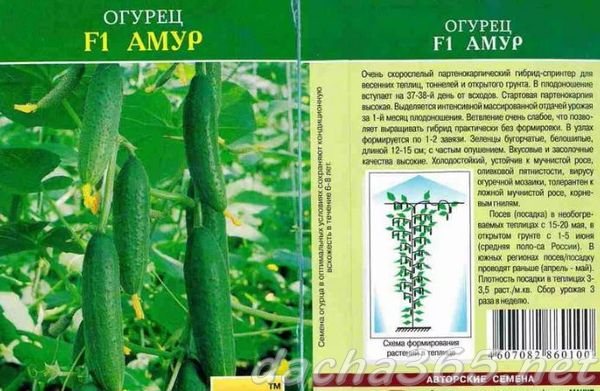

The best varieties of cucumbers that can be planted in open ground in the climatic conditions of the Moscow region are diverse in their characteristics. After examining the proposed descriptions, you can choose the most suitable options for yourself.
Watch the video! The best varieties of open ground cucumbers
Popular types of short-fruited cucumbers
Short-fruited cucumbers are great for growing in open beds. Their distinctive feature is their small size. Most fruits do not exceed 10-12 centimeters in length.
Gherkins are used for fresh cuts, salads, preserves. The disadvantages of the species include exactingness to the ground. Plants react negatively to calcium and potassium deficiencies.
Alex
Alex cucumbers are medium-sized ultra-early self-pollinated hybrids. The first fruits reach technical maturity 40 days after the appearance of the first shoots.
In the leaf axils, up to 3 small ribbed cucumbers are formed. Fruit color is deep green. The peel has small light spots and slight pubescence. The pulp is firm with small seeds. The yield is excellent with a fruiting period until October.
Atlantis
Atlantis is a short-ripening hybrid. It is grown in open areas and under film shelters. Requires insect pollination. The first fruits are removed within 50 days after sowing the seeds. Bushes of medium size, powerful lashes.The leaves are voluminous, wrinkled.
The average length of fruits reaches 14 centimeters, the weight does not exceed 120 grams. The skin of ripe cucumbers is dark green in color. The pulp is juicy, crunchy, there is no bitterness. The variety has a high yield and good keeping quality.
Darling
Darling is a variety of mid-season gherkins. It belongs to the bee-pollinated species. It proved to be excellent for pickling and preservation.
The bushes are powerful, the lashes are distinguished by unlimited growth. The size of ripe fruits reaches 10 centimeters. The rich green peel has small bumps. Cucumbers require regular care: watering, loosening the soil, feeding.
The best varieties of cucumbers for open ground, grown in the Moscow region, are diverse. The above list does not contain all the possible options. Official lists contain about several thousand species. Due to the wide variety, gardeners can independently determine which varieties of cucumbers are suitable for their site.
Late ripening cucumbers
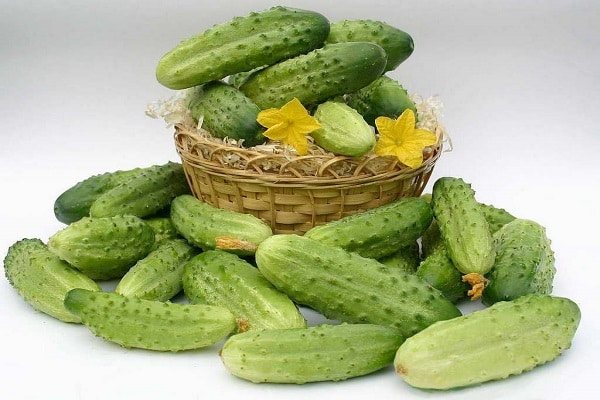

Late-ripening varieties of cucumbers - for open ground. They are pollinated by insects, mature in 2 months and have abundant harvests. These are the best varieties of cucumbers for pickling and canning. If you choose the most productive varieties of cucumbers from the many late varieties, then it is worth stopping at these.
| ‘Nezhinsky’ Ripens in 48-60 days. A high-yielding bee-pollinated variety that allows you to have from 1.6 to 2.1 kg per square meter. harvest. |
|
| ‘Brownie F1’ The hybrid can be grown both outdoors and under a film. Strong-growing plants hold many small cucumbers. You can harvest from it until the end of autumn. |
|
| ‘Crunch F1’ Long-term fruiting hybrid. It is famous for its high yield of cucumbers measuring 8-10 cm and weighing 60-80 grams. Resistant to common diseases. Possesses excellent taste, good canned. |
|
Secrets of Successful Cultivation of Beam Hybrids
To preserve the maximum number of ovaries and get a plant with a long fruiting period, you should strictly follow the seed sowing scheme, which is on the package. When sowing, it is important to avoid thickening. Caring for bouquet cucumbers includes maintaining the temperature regime, regular watering, optimal lighting and environmental humidity. Strongly branched hybrids are advised to be tied to a trellis, as well as pinched in a timely manner.
Good to know!
Pinching stops the growth of green mass and stimulates the formation of the ovary.
The number of dressings should not exceed 4 times a month. Nitrogen-containing fertilizers are applied with caution, because an excess of nitrogen negatively affects the development of ovaries. The number of complex dressings per week should not exceed 15 g per 1 m². For the prevention of diseases, plants are recommended to periodically spray the stems with special growth stimulants. They not only prevent the development of diseases, but also stimulate the emergence of new ovaries.


Fertilizing cucumbers in the greenhouse
To speed up the process of ripening vegetables, experienced gardeners are advised to place a large container with rotted grass or manure in the greenhouse. The contents of the container give off carbon dioxide, which helps to speed up the growth and ripening of the fruit.
Necessary care
Despite the fact that tuft is a genetic factor, the number of ovaries depends largely on the cultivation conditions, plant health. An excess of nitrogen in the soil, a lack of watering, severe overheating, and too rapid growth of the main stem reduce the amount of greenery formed.
Top dressing
Tufted cucumbers need more feed than regular cucumbers. Complex mineral fertilizer is added during watering weekly in small doses - 10–20 g per square meter of plantings. When the number of ovaries decreases, the feeding is cut back.
See also White leaves on cucumbers: what to do and how to process seedlings
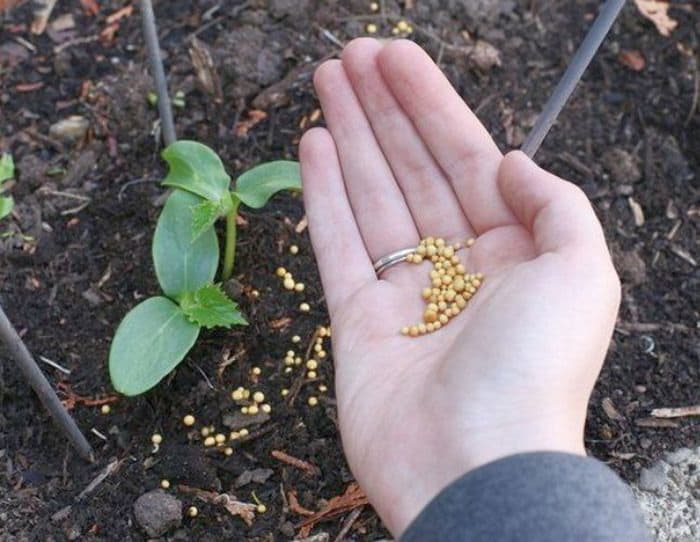

Watering
Bunch cucumbers are watered once every two days or daily if it is hot. Oriented to the topsoil, it should remain moist, but not excessively flooded with water. On waterlogged soils, cucumbers increase the green mass of foliage to the detriment of flowering.
Watering is best done in the evenings, when the sun has gone down, or in the early hours, so as not to burn the leaves through the "lenses" of the drops remaining on them. The water should not be cold.
Shaping and garter
Plants of bunch varieties begin to form a week after planting cucumber seedlings, when 8-9 leaf plates appear. In bundle hybrids, lateral shoots appear in the leaf axils along the entire length of the main stem. If left on, thickening will negatively affect the number of ovaries in the knot, as well as the growth of fruits on the main stem. Therefore, they usually carry out the formation in one stem. This increases the yield, saves labor costs, and improves the taste of the fruit.
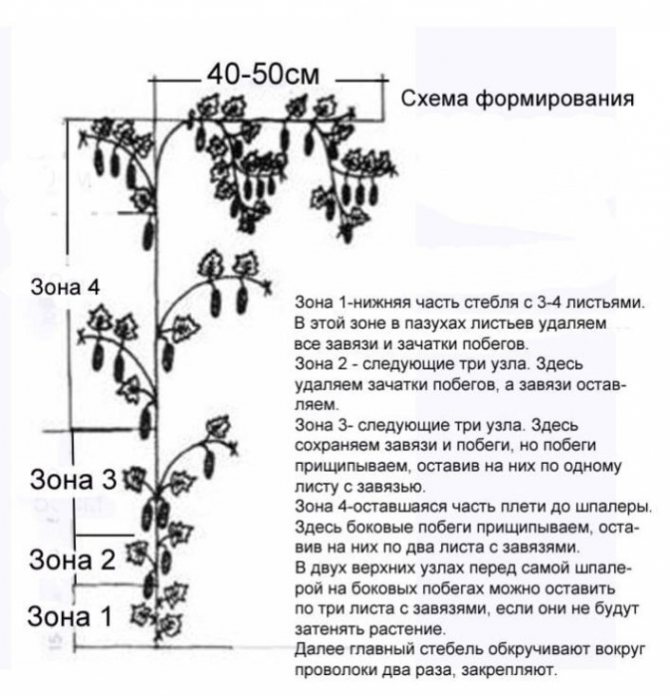

Work technology:
- the lower 4-6 nodes are blinded in advance, even before flowering, the rudiments of lateral shoots and female ovaries are plucked from the leaf sinuses. This will allow the plants to grow faster and build up a powerful leaf apparatus. Those seedlings that have lagged behind in development will take root well;
- along the main stem, the lateral shoots are further removed to the beginning of the trellis wire. Do this while they are small (they have not outgrown 3-5 cm). Leave 2-3 shoots on the main stem under the trellis, before pinching them on 2 leaves;
- when the tip of the shoot grows to the top of the trellis, it is wrapped a couple of times around the wire;
- if it reaches a nearby plant, you need to pinch it.
Thus, in a bunch plant, nutrients are redistributed, the filling of greens on the main stem is stimulated (it should be noted that the share of the yield from it in bunch hybrids is usually at least 60%). Removal of lateral shoots at the bottom and in the middle of the main vine contributes to good aeration, illumination of the lower leaf plates.
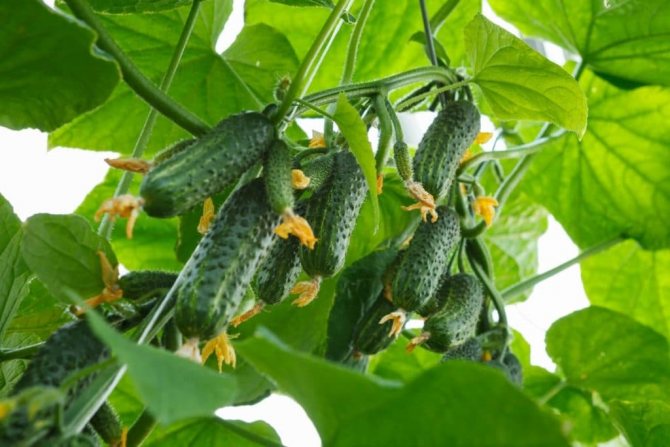

If the formation of bunch varieties is carried out in the manner described above, fruiting will occur a couple of days later, but the yield in a week will be 2-3 times higher than without it.
Prevention of insects and diseases
Fortunately, most varieties of beam hybrids have a stable immunity to the main diseases of the crop, and their early ripening is a guarantee that harmful insects, the main period of development of which occurs at a later date, will not harm them. Nevertheless, to further reduce the risk of disease, it is worth taking care of the appropriate preventive measures:
- observe crop rotation (with the annual cultivation of the same crop, a certain type of pests and pathogens accumulate in the soil);
- carefully remove weeds not only inside greenhouses, but also around them, since many pests find refuge there;
- remove old, dried fruits, flowers from ovaries;
- maintain the healthy state of plants with timely watering and feeding;
- regularly inspect them, especially along the vents, paths, for the timely detection of pests.
It is very important to observe the temperature and humidity regime if bunch varieties grow in a greenhouse. Despite the fact that they love warm and moist soil, overheating reduces the number of ovaries formed, and constant dampness is fraught with the development of putrefactive processes on the roots.
Features of growing cucumbers of bunch type of fruiting
Due to their multiplicity, bundle cucumber plants cannot "feed" all the resulting ovaries. The percentage of the full formation, which means the yield, largely depends on the level of agricultural technology. To grow a good harvest, it is necessary to feed the bushes correctly and often enough, as well as to correctly shape them, taking into account the type of branching. In general, the principles of caring for bunch hybrids do not differ from the rules for caring for ordinary cucumbers.
Lighting
All beam varieties are photophilous. Some of them are adapted to growth in partial shade, but in general, the higher the degree of illumination, the more ovaries are formed in the sinuses. Therefore, the best place for beam hybrids is in sunny areas protected from drafts.
The soil
The requirements for the soil do not differ from those common for any varieties of cucumber crops: well-drained, providing air access to the root system of plants, loose and nutritious. Any cultivated soil with a high organic content is good.
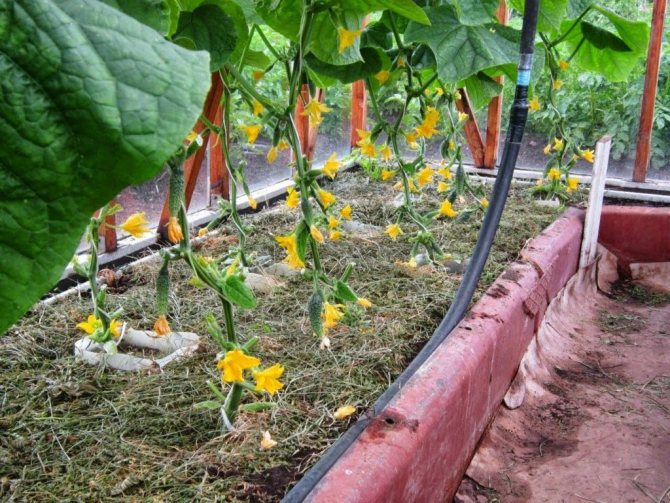

If the ground is heavy, waterlogged and cold. poured ridges with a height of 30-40 centimeters or more with a "warm" layer of organic ingredients.
Wind protection
In the open field, cucumbers need protection from the wind, especially the cold one. If the site is blown out, next to the cucumber beds, in advance, even before planting the main crop, tall plants are sown to create a protective curtain - corn, sunflowers or tall varieties of legumes.

